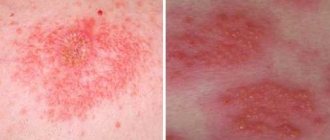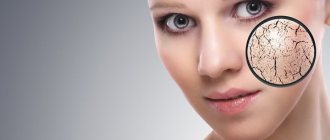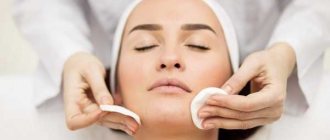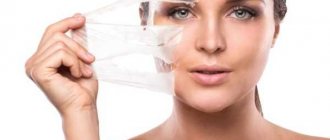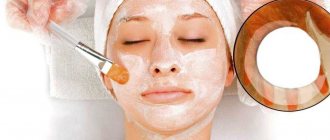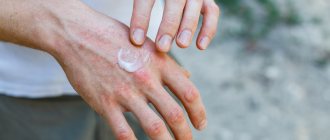The beauties of Ancient Egypt used peeling to cleanse their skin. This word is translated from English as “cleansing, removing the husks.” Cosmetologists call the process during which the top layer of dead cells, along with some living cells, is removed and exfoliated, exfoliation.
As a result, the face returns to youth, attractiveness and a healthy appearance. But in order for beauty to shine faster, the cells that are renewed and work intensively during the period after peeling need to be helped. And this is done with the help of creams and ointments.
What types of peelings are there?
Dead cells are removed by acting on one of three skin levels - this is how peelings differ in depth of penetration.
Superficial, low-traumatic peeling whitens age spots and refreshes the skin without affecting the sensitive layer. Sometimes this type of peeling is used to prepare for cleansing the middle layers of the skin.
The rejuvenating process of medium peeling encourages cell renewal, causes collagen formation and helps lymph flow. Medium peeling is used by girls from 25-27 years old, for which they prepare the skin for the procedure for 2 weeks.
The aggressive deep peeling procedure is compared to plastic surgery, which smoothes out fine and deep wrinkles, eliminates acne marks, scars and evens out the surface of the skin.
Deep peeling, which requires anesthesia, is done using hardware or chemical methods only in a cosmetology clinic.
Classification of peelings by depth
Below is a classification of peelings depending on which layer the acids penetrate.
Superficial peeling – up to the germinal layer of the epidermis (epidermal-dermal junction)
Medium peeling – the entire thickness of the epidermis to the papillary dermis
Deep peeling – up to the reticular layer of the dermis (practically not used in modern cosmetology)
Medium and deep peels are most effective in correcting macrostructural changes in the skin (Deep wrinkles and scars), however, they have a longer and more complex recovery period and an increased risk of scarring and skin dispigmentation.
Peels are also available for home use - Home peels and for professional use - only by specialists in a beauty salon.
Why do you need special skin care after peeling?
Peeling procedures end with a painstaking process of restoring the skin surfaces. Sometimes, if you neglect the recommendations given by the cosmetologist, even with complications.
During a peeling session, the skin receives physical and chemical trauma, which is manifested by active peeling, itching and redness.
The weakened tissues of the upper layer become sensitive and susceptible to all kinds of infections. Such skin cannot cope with recovery without special protection in the form of creams and ointments.
What problems will you face after peeling:
- With peeling, the strength of which is influenced by the applied composition;
- With swelling of the nose, neck, décolleté, if the skin is thin and sensitive;
- With the appearance of pimples on problem skin;
- With age spots and freckles, if there is no sun protection;
- With a rash – a manifestation of an allergic reaction;
- With scars or scars, when the crusts are removed independently.
Therefore, it is so important to choose the right care product and remember to apply it.
What is peeling
Exfoliation (peeling) is a procedure during which dead skin is removed from the facial skin and the surface itself is cleaned. After it, the following consequences may appear:
- peeling - from 2 to 7 days;
- redness (especially after chemical peeling) - up to 5 days;
- slight tingling or burning – up to 2 hours;
- swelling - occurs on thin skin and lasts up to 5 days.
The effect of the procedure is beneficial for the skin, as it starts regeneration processes, activates blood circulation and prevents the appearance of wrinkles. However, peeling is quite harsh, so after the procedure the skin needs to be helped to recover.
What components should be contained in post-peeling products and why?
When choosing post-peeling moisturizers, it is recommended to purchase creams and ointments with substances that help the skin barrier to recover more quickly. In addition, with components that accelerate skin healing and enhance the rebirth of new cells.
And also - with antioxidants.
The basis for cream and ointment should be thermal water.
Cosmetologists advise using the following products:
with hyaluronic and fruit acids;- with amino acids and antioxidants;
- with collagen and alginates;
- with vitamins A, B, C, E, urea and lanolin;
- with natural plant extracts and oils;
- with aloe and algae extracts.
Natural components of medicinal creams and ointments relieve discomfort, moisturize and eliminate tightness. More often, such products are prescribed by a cosmetologist.
Important! You cannot use creams with silicones, parabens and artificial dyes, with fragrances and sodium sulfate laureate, with mineral oil.
Care after superficial peeling
At this stage, only the top layer of skin is affected. All unpleasant sensations disappear after 10 days. Formulations with glycolic, malic, tartaric, citric, lactic or phytic acids are used here.
Basics of care after superficial peeling: refrain from contact with water and direct sunlight for 24 hours, avoid touching your face, reduce time spent outside, drink plenty of fluids. You can also use light mousses and foams, and decorative cosmetics can be introduced as early as day 4. For better recovery, it is recommended to use the GIGI Vitamin E mask.
General rules and recommendations for the recovery period after peeling
After going through the peeling procedure, the main thing is to moisturize and nourish the injured skin, as well as stimulate regeneration.
In addition to these recommendations, you should definitely adhere to other rules:
- Washing is allowed after 24 hours if the peeling is superficial. Medium peeling imposes such a ban for 3 days and allows only warm acidified water. Deep cleansing allows washing on the 5th day.
- Drying with a towel is not allowed; cosmetic wipes should be used to blot moisture.
- Wash with sulfate-free foams (pH 5) and lubricate the skin with medicated cream or gel.
- On the 5-6th day, apply soothing herbal compresses.
- Do not use alcohol-based products. Purchase anti-inflammatory and bactericidal ointments and creams only in pharmacies.
- Use moisturizing, nourishing creams and alginate masks (made from brown algae).
- Use sunscreen with a UV factor of at least 30.
- Applying makeup is allowed after 14-15 days. The foundation should have an anti-comedogenic effect.
- For two weeks you should not drink alcohol, salty or spicy foods, do not go to the bathhouse or sauna, do not sunbathe, and do not go to sports training.
- To restore hydrobalance, you need to drink clean water - 1.5-2 liters per day.
- If the skin condition worsens, antihistamines and antibiotics are prescribed.
- It is forbidden to use a scrub or forcefully remove a layer of crusts.
If peeling is done by a professional and proper care is taken at home, the skin will recover in a short time and complications will not appear.
How to prepare for peeling
To preserve the effect of the procedure longer, the skin must be prepared:
- Use high-quality skincare products every day - for example, GIGI Bioplasma cream.
- Take a course of vitamins to support your immune system.
- Protect your skin from the sun, using creams with protection level of at least 30. Avoid scrubs and hair removal before the procedure.
- Get rid of acute inflammation so that peeling is not painful.
The deeper the peeling, the more thoroughly you need to prepare the skin. Superficial procedures do not require special preparation.
When can you start using creams and ointments?
After the peeling procedure, swelling, peeling, crusts are visible, the skin begins to heal.
Attention! During this period, it is allowed to use only medicinal creams and ointments with anti-inflammatory and wound-healing properties, which are recommended by a cosmetologist. During the first 7 days, cells actively divide, new fibers are formed, which requires moisture and nutrients. At this stage, it is necessary to use products that help wounds heal, soothe inflammation and soften the skin.
On the 3rd day, apply a moisturizer suitable for your skin type to your face, which is tight with dehydration. After 5-7 days, moisturizing with the help of natural masks and decoctions, and the use of nourishing cream are allowed.
Important! If peeling was done in winter, use a nourishing cream more often than a moisturizer.
Buy the best post-peeling cream
On the DAVIANI Shop you can buy the best after-peeling product.
To do this, in the Product Catalog, select “Face” -> “Facial Care” . On this page, select the necessary filters: “Restoration”, “Regeneration”, “Moisturizing”, “Relieves irritation” and “Soothes the skin” .
More than 150 products from famous brands for your choice: Ultraceuticals SPF cream, Thalion products, RHEA mask and other products with proven effectiveness.
Scheme - how to properly apply cream or ointment
In order to quickly revive the skin, when applying a cosmetic product, you should follow these rules:
- Treat the skin with a toner that does not contain alcohol.
- Apply a thin and even layer of cream with gentle, slow movements, moving upwards and to the sides, and also taking into account the direction of the massage lines.
- The product is not rubbed in, but distributed gently with light superficial movements.
- When there are a lot of crusts, the cream is applied 5 times a day. Once the dead skin comes off, two times is enough.
- You will have to use sunscreen or emulsion for 2-3 months before leaving the house.
Carefully! Quick, hasty strokes cause harm to the skin - stretch and injure.
Rules for applying post-peeling cream
To quickly restore the skin when applying the cream, you should follow a number of rules:
- Apply the cream in a thin, even layer after pre-treating the face with an alcohol-free toner;
- Do not rub the cream in, apply with gentle movements;
- during active crust formation, repeat the procedure up to five times a day; after exfoliation of dead skin, reduce the frequency to twice a day.
Apply the selected sunscreen to the skin daily, not only during the healing period of the epidermis, but also for another two months.
TOP 13 creams and ointments for application after peeling
Mandatory care after exfoliation includes the application of moisturizing and soothing creams, the choice of which affects the speed of wound healing and the reduction of discomfort.
D-panthenol
Cream with dexpanthenol or provitamin B5, coenzyme.
Regenerates, heals, and copes with redness and itching in a short time.
Dexpanthenol with vitamin B5
The ointment improves cell metabolism and normalizes protection from external influences.
Compacts collagen fibers and restores tissue and water balance, helps with irritation.
Bepanten
Bepanten ointment is used after damage with medium and deep peeling. The dexpanthenol substance penetrates the tissue, becoming pantothenic acid.
The ointment is useful for accelerating regeneration, healing microcracks and eliminating irritations. Apply a thin layer with light rubbing, first 5 times, then in the morning and evening.
Solcoseryl
Solcoseryl ointment or gel is used after chemical peeling. With blood proteins from calves.
Helps saturate cells with oxygen and produce collagen, enhancing regeneration and accelerating healing. Reduces swelling and inflammation. For post-peeling care and complications with burns.
Vegefarma Cream
Vegefarma Cream is used after laser and chemical peeling. Contains rapeseed and sunflower oil, milk proteins, chamomile and fireweed flower extracts.
Antibacterial, fights inflammation, moisturizes. Used to prevent infections. Relieves redness and irritation.
Baby cream
Regular children's cream for use after superficial and medium peeling 7-10 days after the procedure.
With plant extracts and oils, natural animal fats, beeswax, silicon dioxide, kaolin and other substances. Nourishes, moisturizes, helps protect the skin during sudden temperature changes.
Traumeel
The ointment contains calendula and witch hazel, echinacea and yarrow, chamomile and daisy, arnica, St. John's wort and belladonna.
Anesthetizes, relieves inflammation, irritation and discomfort. Removes swelling with redness. Corrects complications.
Methyluracil
Methyluracil ointment is used after deep peeling or if complications arise. Protects the skin from ultraviolet radiation, promotes healing by accelerating cell regeneration. Relieves inflammation.
Hydrocortisone ointment
Hydrocortisone ointment for treatment after skin trauma by medium and deep peeling. With the hormone hydrocortisone, lanolin, pentol and stearic acid.
After applying the ointment, the skin does not itch, redness and swelling disappear. Antiallergenic agent.
Christina
Protective cream Christina with zinc oxide, shea butter, rosehip and jojoba. With carnauba wax, red clay, alaria extract, vitamins A and E and bisabolol.
Regenerates cells, protects against UV rays, eliminates rashes on oily skin. For a tonal effect. Apply to problem skin of oily and dry type.
Terra mater
Terra mater cream is used after acid peeling and mechanical cleaning. Contains centela asiatica, collagen and vitamin complex.
Moisturizes, gives calm, after which redness and acne disappear, the skin heals faster. Easily spread over cleansed skin and wait 5 minutes.
Bioderma sensibio forte
Bioderma sensibio forte (Sensibio Forte) is useful after laser peeling. With vitamin A and active natural substances.
Hypoallergenic, moisturizing, relieving irritation and inflammation. Apply day and evening to sensitive skin in case of irritation.
La Roche-Posay Hydreane
Composition of moisturizing cream for dry and very dry skin “La Roche-Posay Hydreane” with hydrolipids and glycerin, black currant oil, apricot kernels, coriander and thermal water enriched with selenium. Contains karite butter and bio oils.
Soothes, nourishes and moisturizes. Restores tissue. For dry skin, apply to face and neck twice daily.
The best post-peeling cream: a review of products with proven effectiveness
In addition to moisturizers, you will also need skin cleansing products. The stronger the effect of the procedure, the longer you need to wait before you can use cleansers.
RHEA Gentle Facial Cleanser (sense)
A gentle face product from the Sense line gently cleanses the skin without disturbing the pH balance.
The cleanser contains natural oils and tocopherol, which protect, relieve itching and redness, and soothe the skin.
Buy at DAVIANI Shop: RHEA Gentle Facial Cleanser (sense)
Moisturizers after peeling should contain proteins, panthenol, hyaluronic acid, hydrogels and antioxidants, natural oils and amino acids. Avoid harsh, exfoliating products that contain simple alcohol or vitamin C.
Ultra intense moisturizing cream
Multifunctional cream from Ultraceuticals Ultra Rich Moisturiser Cream is an ideal rehabilitation product after cosmetic procedures, suitable for dehydrated and damaged skin.
Panthenol, urea and sodium hyaluronate intensively moisturize, saturate the skin with oxygen, and strengthen fibroblasts. Caffeine in the cream relieves puffiness, restoring a healthy glow to the face.
Buy at DAVIANI Shop: Ultra intense moisturizing cream
Ultra protective moisturizing cream spf 30 with a light toning effect
Ultraceuticals Ultra Uv Protective Daily Moisturizer Spf 30 Sheer Tint has a dual effect: deeply moisturizes and protects the skin from UV radiation, which is especially important after peeling and other cosmetic procedures.
Active components such as Panthenol, hyaluronic acid and glycerin accelerate cellular metabolism, protect the epidermis and deeply nourish. The product has a weightless texture and is easily absorbed.
Buy at DAVIANI Shop: Ultra protective moisturizing cream spf 30 with a light toning effect
RHEA E-Balm Nourishing facial moisturizer
Moisturizing cream from RHEA E-Balm Nourishing face cream restores the lipid balance of the epidermis, protects and nourishes tissues.
The composition contains natural ingredients: Panthenol, wheat germ oil, jojoba oil and other active substances.
Buy at DAVIANI Shop: RHEA E-Balm Nourishing facial moisturizer
RHEA Revitalizing face mask (sense)
A nourishing face mask from the Sense line restores the skin, has a soothing effect, and fights itching and flaking.
Thanks to allantoin, tocopherol and natural oils in the composition, the mask starts tissue regeneration processes, has an anti-inflammatory effect and promotes healing.
Buy from DAVIANI Shop: RHEA Revitalizing face mask (sense)
The material was prepared by professional cosmetologists of the DAVIANI premium salon. On the website daviani-shop.ru you will find products with proven effectiveness for different skin types, including cellular cosmetics for care, as well as products for hair and nails.
When do you need additional SPF and how to choose it?
Sunscreen is applied to prevent pigmentation before leaving the house, because ultraviolet radiation passes through even dense clouds.
To protect the skin, a product with SPF 50 is suitable, which means that only 1% of the rays will reach the skin. This cream is used for another 2 months after the skin has healed.
3 products with SPF suitable for facial skin after peeling
The sunscreen SPF 50 “Sublime Sun” (L'Oreal Paris) contains jasmine extract and vitamin E. The product moisturizes and rejuvenates the skin, prevents the synthesis of melanin, which inhibits the appearance of hyperpigmentation.
Anti-aging cream “Medium Holy Land Age Defense” (CC Cream SPF50) consists of gingko biloba extract, vitamins E, C, citric acid, including green tea leaves. These substances accelerate regeneration, cope with inflammation and redness.
Anthelios La Roche-Posay cream is recommended for those with sensitive and irritated skin. The product reliably protects against ultraviolet radiation and softens fabrics.
Myths about post-peeling care: what you definitely shouldn’t do
There are many myths about skin care. Some of them can be dangerous even for completely healthy skin.
And after peeling, the skin is irritated and vulnerable, so you should take care of it even more carefully. Therefore, it is important not to be fooled by popular advice, and to know why they are harmful.
One of the most persistent myths is the myth about water with lemon; supposedly you need to wipe your face with water in which natural lemon juice is dissolved a week before the procedure. This is a dangerous misconception!
Lemon juice, even diluted in water, contains citric acid, which can disrupt the pH of the skin, causing irritation and even burns .
Citric acid in cosmetics is strictly controlled by the manufacturer, but home remedies containing it can be harmful.
A similar effect is caused by fresh fruit juice, which lovers of traditional medicine recommend for washing before peeling.
Peeling is a serious procedure, and there is no point in exfoliating the skin again if you are going to have professional exfoliation with products with proven effectiveness.
General recommendations
Post-peeling care is one of the most important components of the procedure; it should not be neglected under any circumstances. It is prescribed by a cosmetologist, since only he knows what product was used during the procedure, what type of skin the woman has and what her reaction is to various products.
The specialist will prescribe professional cosmetics, which will help you spend the rehabilitation period much faster and without complications.
The client is required to follow certain home care rules.
In the first 24 hours it is prohibited:
- Expose your skin to sun exposure.
- Wash.
- Touch your face with your hands or any objects.
- Apply cosmetics or care products.
In the first 2-3 days it is recommended:
- Use products with a neutral pH value to cleanse the skin and wash your face - light foams or gels are suitable.
- Protect skin from exposure to wind, sun, snow, frost and other adverse factors.
In the next 2 weeks it is prohibited:
- Apply decorative cosmetics.
- Touching your face with your hands for no reason.
- Pluck off any crusts that have formed.
- Use scrubs.
- Go to the bathhouse, sauna, swimming pools and solariums.
- Swim in open waters.
- Change your care cosmetics to a different series or brand.
- Use homemade masks (they can become carriers of infection).
- Exercise (sweat will irritate your facial skin).
The recovery period after peeling lasts on average two weeks (if there are no complications), so you can move on to your previous care and use decorative cosmetics only after this time has passed.
Care after deep peeling
Deep peeling with chemicals is a difficult medical procedure, which is performed exclusively for indications: for large scars and significant scars, to eliminate age-related problems or stretch marks. Care after such a procedure includes the following:
- limit contact with the external environment as much as possible - do not go outside again, do not touch your face with your hands;
- use only soft care products, such as foam;
- Do not use decorative cosmetics until the skin is completely healed.
After such a procedure, the skin’s protective barrier weakens, so the body is easily susceptible to diseases. Deep peeling is contraindicated in the following cases: chronic diseases, the entire period of pregnancy and lactation, diseases of the gastrointestinal tract, endocrine and cardiovascular systems. To reduce the likelihood of skin infection, your doctor may prescribe antibacterial agents and pain relievers.
Complications
If peeling is carried out by a qualified cosmetologist, complications mainly occur only in the form of minor skin discomfort. But since the procedure is quite aggressive and the skin reaction is difficult to predict, the following consequences may occur:
- exfoliation of the skin;
- redness for more than 3 weeks;
- formation of pigment spots;
- the appearance of scars;
- swelling of the skin.
The occurrence of such complications requires contacting a specialist and prescribing additional care products. If this is not possible, pharmaceutical drugs can become an emergency aid. The most popular and effective cream is Bapanten 5%. It has a wound-healing, anti-inflammatory effect. It should be applied in such an amount as to prevent the skin from drying out.
Which cream to choose for care after peeling and mesotherapy?
A cosmetologist will definitely advise you on how to care for your skin after peeling and mesotherapy. Based on your individual characteristics, the most effective care will be selected. Of course, it is important to drink enough water and eat a balanced diet.
Our specialists recommend and use professional cosmetics from IMAGE SKINCARE in our salon. It is this company's creams in the PREVENTION+ line that contain the physical protection factors necessary not only for protection, but also for proper care of your skin.
Physical filters are zinc oxide and titanium dioxide. Sometimes they are called mineral filters. Using moisturizing professional cosmetics with SPF factor from IMAGE SKINCARE, you will get ideal results from care after peelings and mesotherapy, avoid irritation and age spots.
Make an appointment with a cosmetologist at the Moscow salon “World of Beauty”
Other peelings
Types of peelings include:
- Laser peels , in the case of hardware laser peels, skin restoration depends, as with acid peels, on the depth of grinding and exfoliation of the skin. That is, rehabilitation is determined by the intensity of the laser effect on the skin.
- Scrubs are rarely used in salon treatments as an independent procedure. However, it is important which components (exfoliating particles) are included in the scrub. Typically, regeneration proceeds comfortably, and care corresponds to that for superficial peelings.
- Enzyme peelings. Considered the weakest and most atraumatic, they are sometimes performed before the chemical peeling procedure in order to prepare it for deeper penetration of acids in subsequent stages. And also for contraindications to chemical peels. No special care is required after enzyme peels.

